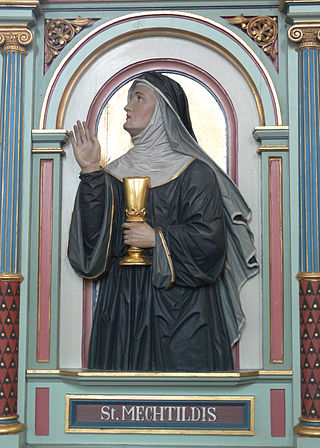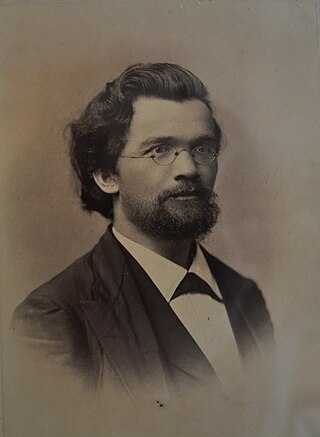
Messianic Judaism is a modernist and syncretic sect that considers itself Jewish. Many consider it a part of the Christian movement of evangelicalism.

Mechthildof Magdeburg, a Beguine, was a Christian medieval mystic, whose book Das fließende Licht der Gottheit is a compendium of visions, prayers, dialogues and mystical accounts. She was the first mystic to write in Low German.
Messianism is the belief in the advent of a messiah who acts as the savior of a group of people. Messianism originated as a Zoroastrian religious belief and followed to Abrahamic religions, but other religions also have messianism-related concepts. Religions with a messiah concept include Judaism (Mashiach), Christianity (Christ), Islam, Druze faith, Zoroastrianism (Saoshyant), Buddhism (Maitreya), Taoism, and Bábism.

In the Light of Truth: The Grail Message was written by Oskar Ernst Bernhardt (1875–1941), and first published in 1926 under the pen name Abd-ru-shin. An expanded, complete edition was published by the author under the name of Abdruschin in 1931, entitled Im Lichte der Wahrheit. It was a collection of 91 lectures, written to build upon each other, presenting a complete picture of Creation. Between 1931 and 1934, a further total of 59 additional lectures were released.
The Gustav-Adolf-Werk (GAW) is a society under the roof of the Evangelical Church in Germany (EKD) which has for its object the aid of feeble sister churches and congregations. It is responsible for the taking care of the diaspora work of the EKD, in cooperation with the EKD itself, its member churches and congregations. The organization started with a focus on the diaspora, but has separate branches internationally in the meanwhile. The organization in Austria is still called the Gustav-Adolf-Verein, which was the original name in Germany as well. Further terms used for the GAW in the past include Gustavus Adolphus Union, Gustav-Adolf-Stiftung and Evangelischer Verein der Gustav-Adolf-Stiftung.
Eranos is an intellectual discussion group dedicated to humanistic and religious studies, as well as to the natural sciences which has met annually in Moscia, the Collegio Papio and on the Monte Verità in Ascona, Switzerland since 1933.
The Düsseldorf School of painting is a term referring to a group of painters who taught or studied at the Düsseldorf Academy roughly between 1819 and 1918, first directed by the painter Wilhelm von Schadow.
Oskar Ernst Bernhardt, also known as Abd-ru-shin or Abdruschin, is best known as the author of The Grail Message.

The Symphony No. 69 is a symphony by Joseph Haydn in C major, Hoboken I/69, known as the "Laudon" symphony. Composed around 1775–1776, it represents a stylistic departure from the composer's earlier intense Sturm und Drang period and was written at the same time as Haydn was writing numerous comic operas. Despite the lighter tone, however, the symphony is "as finely crafted, as interesting, indeed as original, as the preceding ones, albeit very different in character."
Peter Koslowski was a professor of philosophy, especially philosophy of management and organisation and history of modern philosophy, at the Vrije Universiteit Amsterdam.

Günter de Bruyn was a German author.
Christa Reinig was a German poet, fiction and non-fiction writer, and dramatist. She began her career in the Soviet occupation zone which became East Berlin, was banned there, after publishing in West Germany, and moved to the West in 1964, settling in Munich. She was openly lesbian. Her works are marked by black humor, and irony.

National Bolshevism, whose supporters are known as National Bolsheviks and colloquially as Nazbols, is a syncretic political movement committed to combining ultranationalism and communism.
Walter Blume was a German kapellmeister, music critic, and scholar of Johannes Brahms.
Value criticism is a social theory which draws its foundation from the Marxian tradition and criticizes the contemporary mode of production. Value criticism was developed partly by critical readings of the traditions of the Frankfurt School and critical theory. Prominent adherents of value criticism include Robert Kurz, Moishe Postone and Jean-Marie Vincent.

Arnold Dodel-Port was a Swiss botanist and forceful advocate of Darwin's evolutionary theory.

Salomo Friedlaender was a German-Jewish philosopher, poet, satirist and author of grotesque and fantastic literature. He published his literary work under the pseudonym Mynona, which is the German word for "anonymous" spelled backward. He is known for his philosophical ideas on dualism drawing on Immanuel Kant, and his avant garde poetry and fiction. Almost none of his work has been translated into English.

The question of whether the historical Jesus was in good mental health has been explored by multiple psychologists, philosophers, historians, and writers. The first person, after several other attempts at tackling the subject, who broadly and thoroughly questioned the mental health of Jesus was French psychologist Charles Binet-Sanglé, the chief physician of Paris and author of a four-volume work La Folie de Jésus. This view finds both supporters and opponents.








